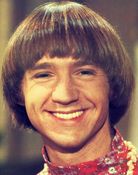
 Peter Tork sang and played bass and keyboard for The Monkees, a television show about a band spoofing The Beatles. The show ran for two years from 1966 to 1968 and won an Emmy Award for outstanding comedy. The band had several songs that became number one on the Billboard charts, including "Daydream Believer," "I’m a Believer," and "Last Train to Clarksville." They sold 75 million records worldwide, which made them one of the biggest-selling groups of all time. On February 21, 2019, at age 77, Tork died from complications of tongue cancer that had been first diagnosed ten years earlier.
Peter Tork sang and played bass and keyboard for The Monkees, a television show about a band spoofing The Beatles. The show ran for two years from 1966 to 1968 and won an Emmy Award for outstanding comedy. The band had several songs that became number one on the Billboard charts, including "Daydream Believer," "I’m a Believer," and "Last Train to Clarksville." They sold 75 million records worldwide, which made them one of the biggest-selling groups of all time. On February 21, 2019, at age 77, Tork died from complications of tongue cancer that had been first diagnosed ten years earlier.
Early Life in Music
He was born Peter Halsten Thorkelson in 1942 in Washington, D.C. His father was an Army officer until the end of World War II, and then became an economics professor at the University of Connecticut. Peter started piano lessons at age nine, and then picked up the banjo, acoustic bass, guitar and French horn. He went to Carleton College, but flunked out and moved to New York City, where he changed his last name to Tork and spent most of his time playing folk music in Greenwich Village.
At age 23, he played with guitarist Stephen Stills and they both moved to Long Beach, California. Stills noticed an ad in Variety Magazine calling for "4 Insane Boys, Ages 17-21," and auditioned for a part in a television show to be called The Monkees. He was turned down because he had bad teeth and inappropriate hair, so he called Tork and suggested that he should try out for the show. The rest is history. Peter Tork became the wisecracking teeneybopper, Michael Nesmith played guitar, Micky Dolenz and Davy Jones played the drums and sang, and The Monkees became the top show on television.
The Monkees
The authors of the show's material included Neil Diamond, David Gates, Neil Sedaka, Jeff Barry, and Bobby Hart. Tork, Nesmith, Jones and Dolenz weren't even allowed to play their own instruments on the show; they just pretended that they were playing, so television critics called The Monkees "the Prefab Four." That changed when they became so popular that they toured and filled sold-out stadiums and had to actually play and sing. Tork and Nesmith were accomplished musicians and Dolenz and Jones were both good singers. At first Tork was disappointed that he was not allowed to contribute any songs, but later he was allowed to write the piano introduction to "Daydream Believer" and the banjo parts on "You Told Me," "For Pete's Sake," "Lady's Baby," and "Do I Have to Do This All Over Again." Nobody listened to Tork's complaints because the band had six Top 10 songs and five Top 10 albums. Tork wanted The Monkees to be the best group of rockers ever, but his mates were happy with their fame as television clowns.
Life After the Show Ended
The show ended in 1968, Tork quit The Monkees in 1969 and the rest of the group broke up in 1971. In the 1970s, Tork played in a mediocre band called Release, spent time in prison for smoking hashish, was a high school teacher, and even worked as a singing waiter. He sought solace in alcohol before eventually giving it up in his forties. Three marriages, to Jody Babb, Reine Stewart, and Barbara Iannoli, ended in divorce. In 2014 he married Pamela Grapes, and they stayed together until his death.
In 1986, at age 44, Tork joined Davy Jones and Micky Dolenz for a successful 20th anniversary reunion tour. In 1996, all four original members of The Monkees recorded "Justus", to celebrate the 30th anniversary of their first album. In 2001, at age 60, Tork had a "meltdown" and dropped out of a group reunion tour. In 2011, they played together again for 45th anniversary concerts in England and the United States. Tork told reporters, "This is not a band. It’s an entertainment operation whose function is Monkees music." In 2012, singer Davy Jones died at age 66 of a heart attack.
A Rare Form of Cancer
In March 2009, Tork was diagnosed with adenoid cystic carcinoma, a rare, slow-growing form of head and neck cancer. He had extensive surgery, but two months later the cancer had returned, so he was treated with radiation. Tork continued to tour and perform while he was receiving treatments. In 2019, ten years after he was first diagnosed, he died of complications from a recurrence of the cancer. Tork was a smoker and drank heavily during part of his life, but unlike other cancers in the head and neck, adenoid cystic carcinoma is not associated with tobacco or alcohol use, or infection with the human papilloma virus (HPV).
Adenoid cystic carcinoma of the tongue originates in the salivary glands and has a high rate of recurrence and of metastasis to the lungs, liver and bones (International J of Oral Health Sciences, Feb 13, 2017;6(2):92-95). Most people with this cancer are alive five years after the original diagnosis. There is no difference in five-year survival rates between treatments with surgery, radiation, or both surgery and radiation (Int J Radiat Oncol Biol Phys, 1987;13:673–8), and survival rates have not changed over the years (Head Neck Oncol, May 29, 2009;1: 15). The cancer usually starts as a painless and slowly-growing lump inside the mouth, under the tongue or inside the cheek. It can also occur in the nose, breast or vulva. It does not appear to be genetic and rarely runs in families. It appears to develop from genetic alterations caused by a person´s environment, such as through exposure to radiation or carcinogens (Adenoid Cystic Carcinoma Research Foundation, www.accrf.org, 2019).
Feb 13, 1942 – Feb 21, 2019